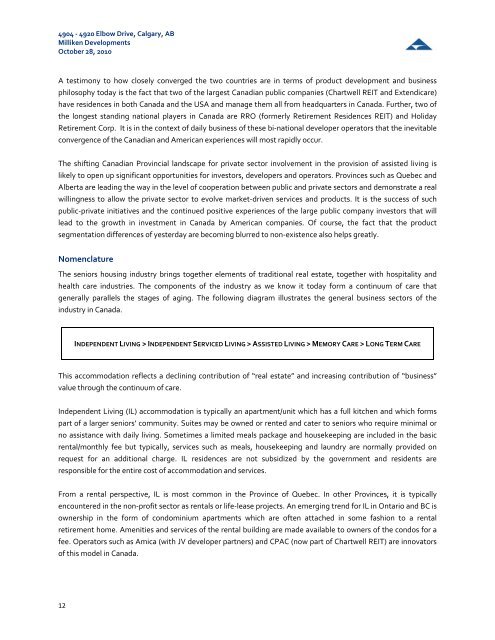Altus Feasibility Study (pdf) - Maison Senior Living
Altus Feasibility Study (pdf) - Maison Senior Living
Altus Feasibility Study (pdf) - Maison Senior Living
You also want an ePaper? Increase the reach of your titles
YUMPU automatically turns print PDFs into web optimized ePapers that Google loves.
4904 ‐ 4920 Elbow Drive, Calgary, AB<br />
Milliken Developments<br />
October 28, 2010<br />
A testimony to how closely converged the two countries are in terms of product development and business<br />
philosophy today is the fact that two of the largest Canadian public companies (Chartwell REIT and Extendicare)<br />
have residences in both Canada and the USA and manage them all from headquarters in Canada. Further, two of<br />
the longest standing national players in Canada are RRO (formerly Retirement Residences REIT) and Holiday<br />
Retirement Corp. It is in the context of daily business of these bi‐national developer operators that the inevitable<br />
convergence of the Canadian and American experiences will most rapidly occur.<br />
The shifting Canadian Provincial landscape for private sector involvement in the provision of assisted living is<br />
likely to open up significant opportunities for investors, developers and operators. Provinces such as Quebec and<br />
Alberta are leading the way in the level of cooperation between public and private sectors and demonstrate a real<br />
willingness to allow the private sector to evolve market‐driven services and products. It is the success of such<br />
public‐private initiatives and the continued positive experiences of the large public company investors that will<br />
lead to the growth in investment in Canada by American companies. Of course, the fact that the product<br />
segmentation differences of yesterday are becoming blurred to non‐existence also helps greatly.<br />
Nomenclature<br />
The seniors housing industry brings together elements of traditional real estate, together with hospitality and<br />
health care industries. The components of the industry as we know it today form a continuum of care that<br />
generally parallels the stages of aging. The following diagram illustrates the general business sectors of the<br />
industry in Canada.<br />
12<br />
INDEPENDENT LIVING > INDEPENDENT SERVICED LIVING > ASSISTED LIVING > MEMORY CARE > LONG TERM CARE<br />
This accommodation reflects a declining contribution of “real estate” and increasing contribution of “business”<br />
value through the continuum of care.<br />
Independent <strong>Living</strong> (IL) accommodation is typically an apartment/unit which has a full kitchen and which forms<br />
part of a larger seniors’ community. Suites may be owned or rented and cater to seniors who require minimal or<br />
no assistance with daily living. Sometimes a limited meals package and housekeeping are included in the basic<br />
rental/monthly fee but typically, services such as meals, housekeeping and laundry are normally provided on<br />
request for an additional charge. IL residences are not subsidized by the government and residents are<br />
responsible for the entire cost of accommodation and services.<br />
From a rental perspective, IL is most common in the Province of Quebec. In other Provinces, it is typically<br />
encountered in the non‐profit sector as rentals or life‐lease projects. An emerging trend for IL in Ontario and BC is<br />
ownership in the form of condominium apartments which are often attached in some fashion to a rental<br />
retirement home. Amenities and services of the rental building are made available to owners of the condos for a<br />
fee. Operators such as Amica (with JV developer partners) and CPAC (now part of Chartwell REIT) are innovators<br />
of this model in Canada.


